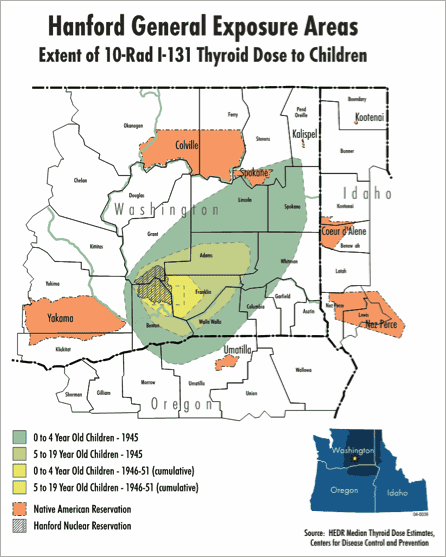The United States government began construction at Hanford in south central Washington State in 1943. Three nuclear reactors and two chemical processing plants were built and operated at Hanford during the Manhattan Project to develop nuclear weapons for use in World War II. The U.S. government retained private contractors including DuPont and General Electric to oversee the production of materials for nuclear weapons.
Because of the war time pressure and inexperience with radioactive materials, the routine production of plutonium fuel for the reactors resulted in the release of large quantities of radioactive materials into the air, water and soil around the plants, including large amounts of iodine-131. Hanford did not install filters on the stacks of the plutonium processing plants until 1948. After 1948, Hanford continued to release radioactive materials and other hazardous chemicals into the air, soil and water including the Columbia River. By 1955, there were eight reactors in operation at Hanford. River water from the Columbia was used to cool these reactors and was contaminated with radioactivity, toxic chemicals and excessive heat.
Over four billion gallons of contaminated liquids were released by Hanford operations. These releases contaminated over two hundred square miles of ground water under Hanford. In the 1960s Hanford began shutting down reactors and plants with the last plutonium plant and reactor being shut down in the late 1980s as a result of complaints by citizen action groups that the plants could not be operated safety without danger to the environment.
In 1986, a release of millions of pages of Hanford documents by the U.S. Department of Energy revealed that over seventy five thousand square miles had been contaminated with radioactivity by Hanford’s operations. The Columbia River carried radioactivity as far as the Washington and Oregon coasts. Contaminated air from Hanford is thought to have traveled over Washington, Oregon, Idaho, Montana and parts of Canada.
People who lived downwind from Hanford or who used water from the Columbia River downstream from Hanford were exposed to levels of radiation far above normal background levels from breathing contaminated air or consuming foods such as milk and cheese from cows and goats who grazed on contaminated vegetation. The contamination in the water of the Columbia River was concentrated in the fish and other aquatic life in the river. The waterfowl and other wildlife in the area which fed on the fish then became contaminated. The contaminated fish were especially injurious to the Native Americans who depend on the salmon in the Columbia River for their livelihood.
Estimates of the number of people who may have had their health threatened by radioactivity released by Hanford over the past seventy years are as high as two million. The U.S. Department of Energy collaborated with the Hanford Health Information Network to educate the public on the dangers of radiation release from Hanford. Class action law suits have been working their way through the courts for years seeking compensations for health problems caused by Hanford radiation.
